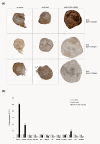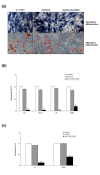SOX9 gene transfer via safe, stable, replication-defective recombinant adeno-associated virus vectors as a novel, powerful tool to enhance the chondrogenic potential of human mesenchymal stem cells
- PMID: 22742415
- PMCID: PMC3583131
- DOI: 10.1186/scrt113
SOX9 gene transfer via safe, stable, replication-defective recombinant adeno-associated virus vectors as a novel, powerful tool to enhance the chondrogenic potential of human mesenchymal stem cells
Abstract
Introduction: Transplantation of genetically modified human bone marrow-derived mesenchymal stem cells (hMSCs) with an accurate potential for chondrogenic differentiation may be a powerful means to enhance the healing of articular cartilage lesions in patients. Here, we evaluated the benefits of delivering SOX9 (a key regulator of chondrocyte differentiation and cartilage formation) via safe, maintained, replication-defective recombinant adeno-associated virus (rAAV) vector on the capability of hMSCs to commit to an adequate chondrocyte phenotype compared with other mesenchymal lineages.
Methods: The rAAV-FLAG-hSOX9 vector was provided to both undifferentiated and lineage-induced MSCs freshly isolated from patients to determine the effects of the candidate construct on the viability, biosynthetic activities, and ability of the cells to enter chondrogenic, osteogenic, and adipogenic differentiation programs compared with control treatments (rAAV-lacZ or absence of vector administration).
Results: Marked, prolonged expression of the transcription factor was noted in undifferentiated and chondrogenically differentiated cells transduced with rAAV-FLAG-hSOX9, leading to increased synthesis of major extracellular matrix components compared with control treatments, but without effect on proliferative activities. Chondrogenic differentiation (SOX9, type II collagen, proteoglycan expression) was successfully achieved in all types of cells but strongly enhanced when the SOX9 vector was provided. Remarkably, rAAV-FLAG-hSOX9 delivery reduced the levels of markers of hypertrophy, terminal and osteogenic/adipogenic differentiation in hMSCs (type I and type X collagen, alkaline phosphatase (ALP), matrix metalloproteinase 13 (MMP13), and osteopontin (OP) with diminished expression of the osteoblast-related transcription factor runt-related transcription factor 2 (RUNX2); lipoprotein lipase (LPL), peroxisome proliferator-activated receptor gamma 2 (PPARG2)), as well as their ability to undergo proper osteo-/adipogenic differentiation. These effects were accompanied with decreased levels of β-catenin (a mediator of the Wnt signaling pathway for osteoblast lineage differentiation) and enhanced parathyroid hormone-related protein (PTHrP) expression (an inhibitor of hypertrophic maturation, calcification, and bone formation) via SOX9 treatment.
Figures




References
-
- Wakitani S, Okabe T, Horibe S, Mitsuoka T, Saito M, Koyama T, Nawata M, Tensho K, Kato H, Uematsu K, Kuroda R, Kurosaka M, Yoshiya S, Hattori K, Ohgushi H. Safety of autologous bone marrow-derived mesenchymal stem cell transplantation for cartilage repair in 41 patients with 45 joints followed for up to 11 years and 5 months. J Tissue Eng Regen Med. 2011;5:146–150. doi: 10.1002/term.299. - DOI - PubMed
Publication types
MeSH terms
Substances
LinkOut - more resources
Full Text Sources
Other Literature Sources
Research Materials
Miscellaneous

